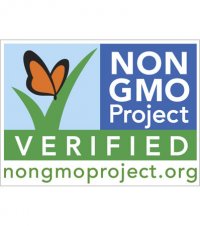Hopefully Going More Natural at the Supermarket – Where to Start gave you a good foundation of how to shop for foods that will keep your family healthy instead of making them sick (by sick I don’t necessarily mean symptoms that you see right away, but rather long term illness such as cancer, Alzheimer’s, diabetes, etc.). So now, here is the next step to take on your journey of eating naturally:
Do Your Best to Avoid GMO’s (genetically modified food), otherwise known as “frankenfood.” What does this mean? It means that the producers of our food, such as Monsanto, are messing with the genetics of these vegetables; “genes from other plants, viruses, bacteria, animals, etc. are inserted into the genes of certain products, such as corn, to make them more stable and resistant to drought, disease and pesticides” (The Good Human). The problem is that the cost of these ‘superpowers’ is our health, with connections to infertility, allergies and cancer.
Unless what you are buying is 100% certified organic, chances are that you are eating genetically modified food, as between 70% and 80% of corn and 93% of soybeans in the U.S. are genetically modified (this includes soybean and corn oils) and soy and corn are the main ingredients in a majority of our foods. Foods that contain GMOs do not have to be labeled as such. What’s scary is that you may not even know corn is involved. For example, the chickens and cows whose meat, eggs and milk are labeled as all natural and vegetarian fed are fed genetically modified corn, which means you too are eating the GMOs that they ate. As far as produce, you can’t be sure that you aren’t getting genetically modified food unless you look for the codes that are provided on the stickers on the vegetables and fruits you are buying, and even at that you can’t be 100% sure. Here is a key to understanding the numbers and an explanation as to why they don’t mean much when it comes to GMOs:
Organic produce has a five-digit number beginning with a 9. Organic bananas, for example, would be given the designation of 94011. This is the ONLY produce where GMO seeds are guaranteed not to be used, yet it doesn’t mean they are definitely GMO free. “The U.S. and Canada both prohibit 100% certified organic food from containing GMO ingredients. However, contamination of the crops may cause organic feed to contain some percentage of GMO ingredients” (Brown).
Conventional produce (grown with pesticides) has a four-digit number beginning with a 3 or 4. Therefore, the number on conventionally grown bananas would be 4011. Because genetically modified food does not have to be labeled, it is more than likely that fruits and veggies with four digit codes are genetically modified.
Genetically engineered produce has a five-digit number on the label and begins with an 8. Again, the number on genetically altered bananas would be 84011. *** You will probably never see a piece of produce with the number 8 in front of it! The reason for this is because it was once labeled with it’s own number (8) because the companies engineering the food wanted it to have it’s own code, thinking it would be popular and people would want to buy it, thus we would need to be able to identify it. Since this is not the case, the companies have stopped labeling it so that consumers cannot distinguish it from the other conventional produce (Food Renegade).
Why You Should Think Twice Before Consuming GMOs:
1. Introducing one gene into another has a very likely potential to create harmful, toxic compounds and since this process is relatively new in regards to being used in the food we are now consuming, we have no idea what effects this could have on our bodies.
2. Genetically modified crops are NOT being regulated by the FDA or any government run agency (not that this totally matters being that even things that are regulated by them have caused injury and death).
3. Things like tobacco, asbestos, DDT and many drugs approved by the FDA were once declared safe for many years before it was realized just how life threatening they all are!
4. “The truth is that many natural health experts claim that there is a growing amount of evidence that genetically modified foods have a link to food allergies, intestinal damage, autoimmune disorders, anemia, diabetes, infertility and even cancer. Independent scientific studies done on the effects of genetically modified foods have produced some incredibly troubling results”(Emergency Food Supply).
5. “Before the FDA decided to allow GMOs into food without labeling, FDA scientists had repeatedly warned that GM foods can create unpredictable, hard-to-detect side effects, including allergies, toxins, new diseases, and nutritional problems. They urged long-term safety studies, but were ignored. Since then, findings include: Thousands of sheep, buffalo, and goats in dying in India after grazing on Bt cotton plants, mice eating GM corn for the long term had fewer, and smaller, babies, more than half the babies of mother rats fed GM soy died within three weeks, and were smaller, by the third generation, most GM soy-fed hamsters lost the ability to have babies, soy allergies skyrocketed by 50% in the UK, soon after GM soy was introduced, and the stomach lining of rats fed GM potatoes showed excessive cell growth, a condition that may lead to cancer”(Institute for Responsible Technology).
How You Can Start Avoiding GMO’s:
1. If the produce has a label, make sure that it begins with the number 9 (certified organic).
2. Buy 100% certified organic products, especially those foods that are made using the most commonly genetically modified ingredients. The top foods that contain GMOs are: corn (this includes corn oil, corn starch & corn flour), soy (including soybean oil), potatoes (Burbank Russet variety), tomatoes* (keep this in mind when buying jars of sauce or canned tomatoes), canola, cottonseed oil, papaya, radicchio, squash and salmon (only buy wild caught salmon – if it is farm raised there is a high chance that it is genetically modified). (Healthy Child Healthy World). *Supposedly no GMO tomatoes are currently being sold.
3. People don’t often realize that most brands of mayonnaise contain GMOs. Buy certified organic mayonnaise; it’s a bonus if it says Non-GMO. It probably will NOT taste the same as the Hellmann’s that you are used to, but it’s not too different and you will get used to it.
 4. Look for the NON GMO Project label, search for verified NON GMO products on the NON GMO Project Database or find a retailer that supports non GMO foods here: Find Retailer
4. Look for the NON GMO Project label, search for verified NON GMO products on the NON GMO Project Database or find a retailer that supports non GMO foods here: Find Retailer
5. Print out this guide and take it to the store with you: True Food Now
6. Download an app for avoiding GMO foods here: True Food Now App
SOURCES
Adoption of Genetically Engineered Crops in the US. Data Sets. United States Department of Agriculture’s Economic Research Service. July 1, 2011. Web. January 31, 2012.
Brown, Alice Elliot. Can GMO Food Be Organic? Blogcritics Taste. Web. February 4, 2012.
93 Percent of Soybeans and 80 Percent of Corn In The U.S. Grow From Seeds Genetically Modified by Monsanto. Emergency Food Supply. Web. February 5, 2012.
GE Food. Center For Food Safety. The True Food Network. Web, February 4, 2012.
GMO Health Dangers. Institute for Responsible Technology. Web. February 4, 1012.
M. Kristen. PLU Codes Don’t Indicate GMO Produce. Food Renegade. Web. February 4, 2012.
Top Ten Genetically Engineered Food Crops. Healthy Child Healthy World. Web. January 31, 2012.
True Food Shopper’s Guide: How to Avoid Foods Made with Genetically Modified Organisms. Center For Food Safety. The True Food Network. Web, February 4, 2012.
What Are GMOs and Why You Should Avoid Them. The Good Human. September 18, 2007.

Keep up the good work. 🙂